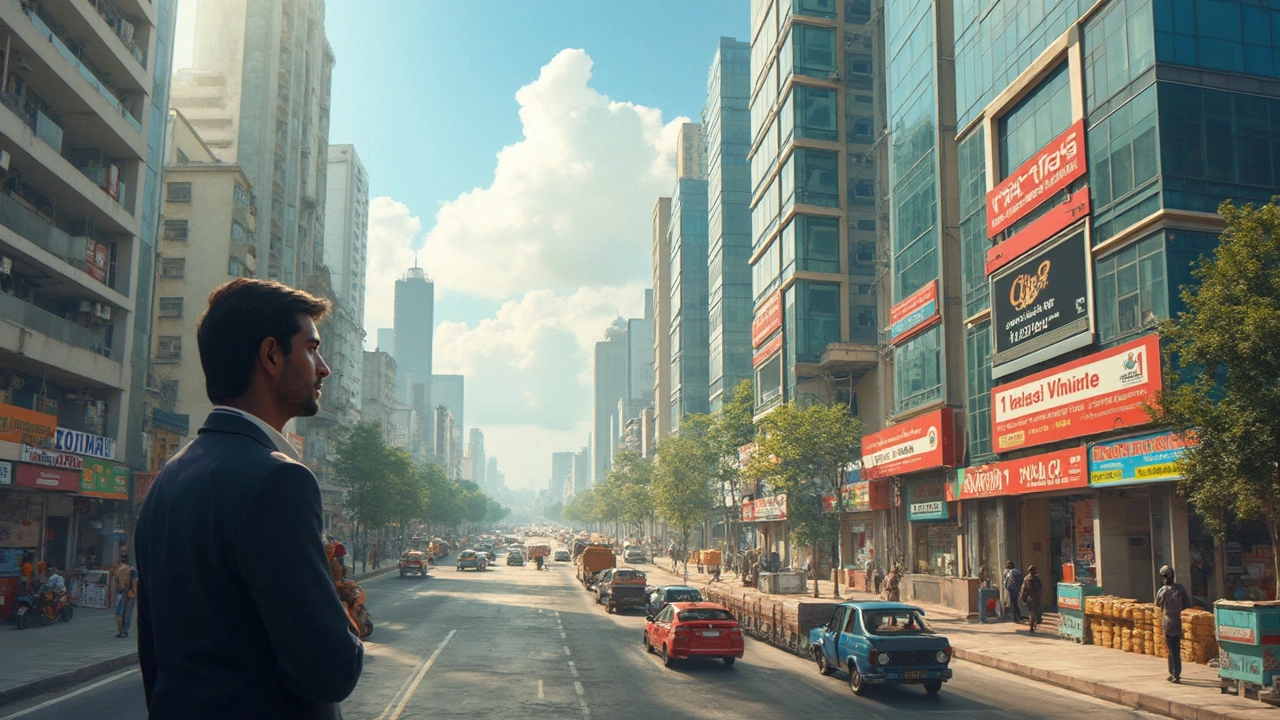Trying to figure out which commercial property type is best? The answer isn’t one-size-fits-all. Some people get pulled in by the shiny promise of retail spaces, while others swear by warehouses—especially with the whole e-commerce boom. But here’s the thing: the “best” really depends on what you’re looking to get out of it, how much risk you’re willing to take, and your local market.
Office buildings have been the classic choice for a long time, but things have changed since more folks started working from home. Retail can look tempting, especially in highly-trafficked areas, but if a pandemic hits or shopping habits shift, your tenants might disappear fast. On the other hand, industrial properties—like warehouses—are almost boring in their reliability. A lot of investors love them for steady income and low fuss.
Don’t just copy someone else’s plan. Think about what works for your investment goals. Is cash flow your main concern? Or are you hoping for long-term growth? The commercial property landscape is loaded with options, but you need to pick what’s honest-to-goodness realistic for you. Start by looking at where demand is growing in your area, the kind of tenants you want to deal with, and how much time you plan to spend managing things. Make your pick based on solid numbers, not just what’s hot on social media.
- Understanding Commercial Property Types
- Comparing Returns and Risks
- Location and Market Trends Matter
- Tenant Needs and Lease Structures
- Which One Fits You Best?
Understanding Commercial Property Types
The word "commercial property" covers a pretty wide range. If you’re new to investing or just shopping around for your first deal, it's good to know what you’re actually looking at. The three most common commercial property types are office, retail, and industrial—though there are more out there, like mixed-use, hospitality (think hotels), and even specialty spots like medical clinics or storage units.
Let's break down the basics:
- Office buildings: These range from small suburban office parks to huge downtown skyscrapers. They’re usually split into three classes: Class A (newest and fanciest), Class B (middle of the road), and Class C (older, sometimes needing repairs). People used to see offices as a steady bet, but remote work and shifting business needs have shaken things up a bit.
- Retail spaces: Think strip malls, stand-alone shops, and big-box centers. Retail took a hit during the pandemic, but spots in prime neighborhoods can still be gold—especially now that lots of brands are pushing back into physical stores. The catch? Tenant turnover can be high, and location is everything.
- Industrial/warehouse: Warehouses, fulfillment centers, and manufacturing buildings fall here. If you're following the e-commerce wave, you’ll notice these properties are in crazy high demand thanks to sites like Amazon. They usually come with longer leases and less drama compared to other property types.
- Multifamily (apartments): Technically, larger apartment buildings count as commercial real estate. The cool part: everyone needs a place to live. There’s almost always solid demand, though rising interest rates can squeeze profits.
Here’s a handy table comparing the main types:
| Type | Typical Lease Length | Main Tenants | Main Risk |
|---|---|---|---|
| Office | 3-10 years | Businesses, professionals | Market shifts, remote work |
| Retail | 1-10 years | Shops, restaurants | Trends, location, economy |
| Industrial | 5-15 years | Logistics, manufacturers | Specialized needs, location |
| Multifamily | 1 year (typical, per unit) | Renters | Tenant turnover, regulation |
Knowing these basics helps you weigh your options before you even look at a single deal. Picking the right type of commercial property really comes down to what fits your goals—and what you’ll actually enjoy owning or managing over the long term.
Comparing Returns and Risks
When picking a commercial property type to buy, the real question is: how much can you make—versus how much you could lose? The returns and risks for each type can be pretty different, and you’ll want to weigh them carefully before pulling the trigger.
Office buildings used to be considered a safe bet for steady cash flow, with national tenants locking in long leases. But now, post-pandemic, vacancy rates in some downtown areas are way up. According to a 2024 JLL report, office vacancy in major U.S. cities hit around 19%. Higher vacancy means more time without rent and sometimes, lower rents just to get tenants in.
Retail spaces can go big if you land a popular chain store as a tenant, and properties in high-traffic locations tend to hold their value. On the flip side, retail is sensitive to the economy and trends. If your tenant can’t keep up with online shopping competition, it can sit empty for months. Shorter lease terms make retail a bit riskier for stable income, but with some luck and strong demand, the returns can outweigh office investments.
Industrial spaces—including warehouses and distribution centers—have jumped in demand with e-commerce. These usually offer practical, low-maintenance buildings and tenants who stay longer. According to CBRE, industrial vacancy rates dropped below 5% in many areas last year, and rents keep climbing. The risk? If supply chain trends shift or the area loses its appeal, these too can take a hit, but right now, they’re among the most solid bets for reliable rent.
| Property Type | Average Annual Yield | Typical Lease Length | Risk Level |
|---|---|---|---|
| Office | 6-8% | 5-10 years | Medium-High |
| Retail | 5-10% | 3-7 years | Medium-High |
| Industrial | 6-9% | 5-15 years | Low-Medium |
Chasing higher yields seems tempting, but remember: higher returns usually come with higher risks. Vacancy, lease length, tenant credit, and local market health all play a role. So dig into recent market trends before you jump in. Don’t ignore the details—a reliable tenant on a long lease in a boring warehouse beat a vacant, flashy retail spot any day.

Location and Market Trends Matter
Here’s a hard truth—no matter how much you spend fixing up a commercial property, you can’t outsmart a bad location. If a commercial property sits in an area where tenants struggle or customers just don’t show up, your investment is going nowhere fast. Big city, small town, it doesn’t matter. Location rules everything. Even with the rise of remote work, the right address is still a magnet for business, especially in areas where folks want to be.
Trends change, and so do hot spots. Warehouse demand exploded near highway hubs thanks to e-commerce companies like Amazon. Meanwhile, some office buildings and malls in classic downtowns now deal with more empty space as people work from home or shop online. If you want the best commercial property type for your area, follow the money and see where companies are moving in—or moving out.
Pay attention to growth stats in your city. New residential projects nearby? That’s usually good news for retail and office demand. Tech startups flocking to your region? Flexible workspaces or industrial flex units might become prime real estate. According to CBRE’s 2024 report, industrial space vacancy hit 3.5% in prime logistics corridors, down from over 5% just three years before.
| Property Type | Recent Vacancy Rate (%) | 2024 Trend |
|---|---|---|
| Industrial/Warehouse | 3.5 | Downward, high demand |
| Office | 16.4 | Upward, tough market |
| Retail | 6.7 | Mixed bag: Neighborhood centers solid, malls struggling |
Local knowledge matters more than ever. Don’t assume what’s trending nationwide is the same as your backyard. In smaller cities, local hospitals and schools can keep demand alive for office or retail, no matter what the national headlines say. Always check out which businesses are signing leases and what types of properties they’re picking.
Want some advice from the pros? Sam Chandan, a real estate economist at NYU, nailed it:
“The market doesn’t care what you want; it cares where tenants want to be.”Bottom line? Watch for what’s really happening where you want to buy, not just what looks good from far away.
Tenant Needs and Lease Structures
So, you’re eyeing the world of commercial property. Here’s something you can’t skip: understanding what different tenants actually want and how leases usually work in each type of property. If you don’t nail this down, you’ll end up with empty spaces and less rent coming in.
Let’s break it down: office tenants typically want flexibility these days. Shorter lease terms, the option to scale up or down, and access to extras like parking and fast internet aren’t just “nice to have” anymore. For retail tenants, it’s all about visibility, foot traffic, and how easy it is for their customers to get in and out. Industrial folks, like warehouse tenants, usually care more about loading docks, high ceilings, and space for trucks to move around. Sounds basic, but the devil’s in these details.
Lease structures matter just as much. In commercial deals, you normally see these:
- Gross lease: The landlord covers almost everything—taxes, insurance, maintenance—so tenants like the simplicity.
- Net lease: The tenant pays base rent plus a split of other costs (can be single, double, or triple net, and the more 'nets,' the more expenses tenants cover). Warehouses and retail spots often use triple net leases.
- Percentage lease: Common in retail. Base rent plus a percentage of sales if a shop is raking in big numbers.
Here’s a quick look at what you might expect from lease lengths and structures in popular commercial property types:
| Property Type | Average Lease Term | Most Common Lease Structure |
|---|---|---|
| Office | 3–7 years | Gross, Modified Gross |
| Retail | 5–10 years | Net, Percentage |
| Industrial | 3–10 years | Triple Net (NNN) |
If you’re after low-hassle steady income, industrial’s triple net deal is king: the tenant pays almost everything, so you’re not acting like a part-time building manager. Retail and office can offer stability too, but you need the right location and lease structure.
If you ask folks who manage big buildings, they’ll tell you: getting the lease right is just as important as picking a prime location. Cushman & Wakefield, a global real estate giant, put it simply:
“The right lease structure doesn’t just protect income—it can mean the difference between owning a cashflow machine or a headache.”
Bottom line? Listen to what your target tenants actually want, make sure the lease matches up, and never assume all commercial deals follow the same playbook. The type of commercial property you buy should fit both your goals and your future tenants’ needs—otherwise, you’ll spend more time chasing new renters than counting rent checks.

Which One Fits You Best?
Let’s make it simple: There’s no magic answer for the best commercial property. It comes down to your goals, budget, and even your nerves. Do you want regular cash flow with less hassle? Warehouses and industrial spaces often have long leases—many last five years or even longer. That means fewer headaches with turning over tenants. The e-commerce push since 2020 has made these spaces even more attractive, with national real estate reports showing industrial rent growth up 8% year-over-year.
If you’re after walk-ins and growth potential, retail might call your name. High-traffic spots, like shopfronts near urban centers, can bring in solid returns if you pick a niche that shoppers still crave in person—think food, health, or boutique experiences. But brace yourself: retail is more sensitive to the economy, so your income can dip if the area changes or consumer habits shift.
Office buildings are a strong bet if you’re in a city where big companies are returning to in-person work. Some suburban areas have actually seen a rise in office demand post-pandemic, especially for flexible or smaller spaces. But you’ll need to watch vacancy rates and local news about company moves. If you hate chasing after late rent or dealing with multiple small tenants, larger office buildings with anchor tenants (think: big brands) can make your life easier, though these properties cost more upfront.
- Want steady, low-hassle? Industrial/warehouse properties are your friend.
- Ready for higher risk, higher reward? Retail in prime areas could pay off.
- Prefer long-term tenants? Office buildings with established companies fit best.
Check the local market, too. For instance, in 2024, Dallas saw a 6% increase in warehouse occupancy, while parts of San Francisco still struggle to fill office spaces. This stuff isn’t the same everywhere—one city’s winner is another’s loser.
Bottom line: Grab recent data, talk to local brokers, and get clear on what you’re willing to manage. Don’t just buy what’s trending; buy what actually fits your plan and lifestyle. That’s how seasoned investors avoid regrets.

